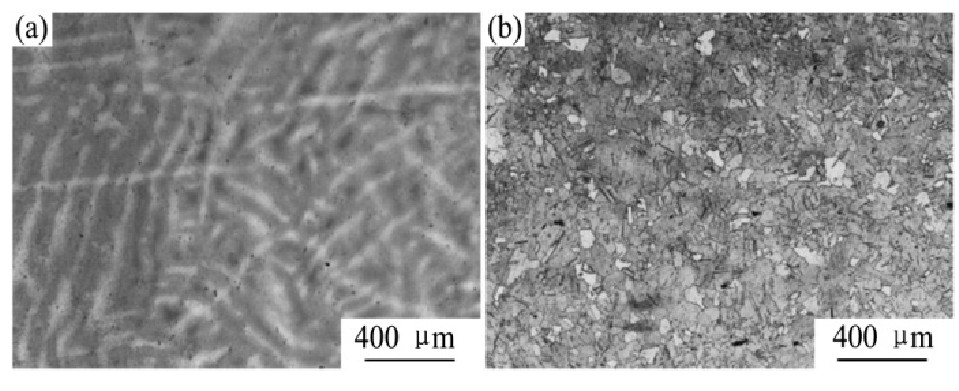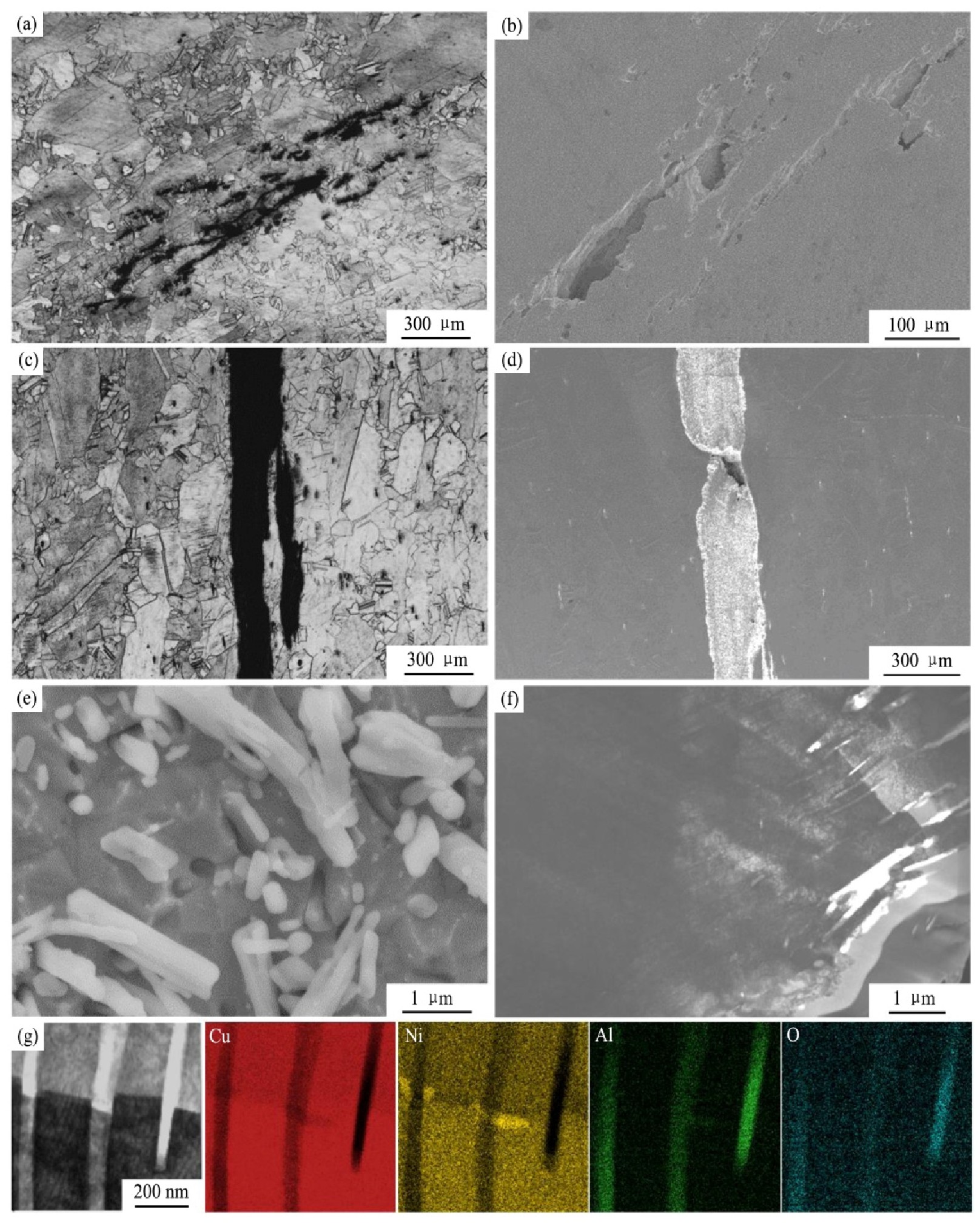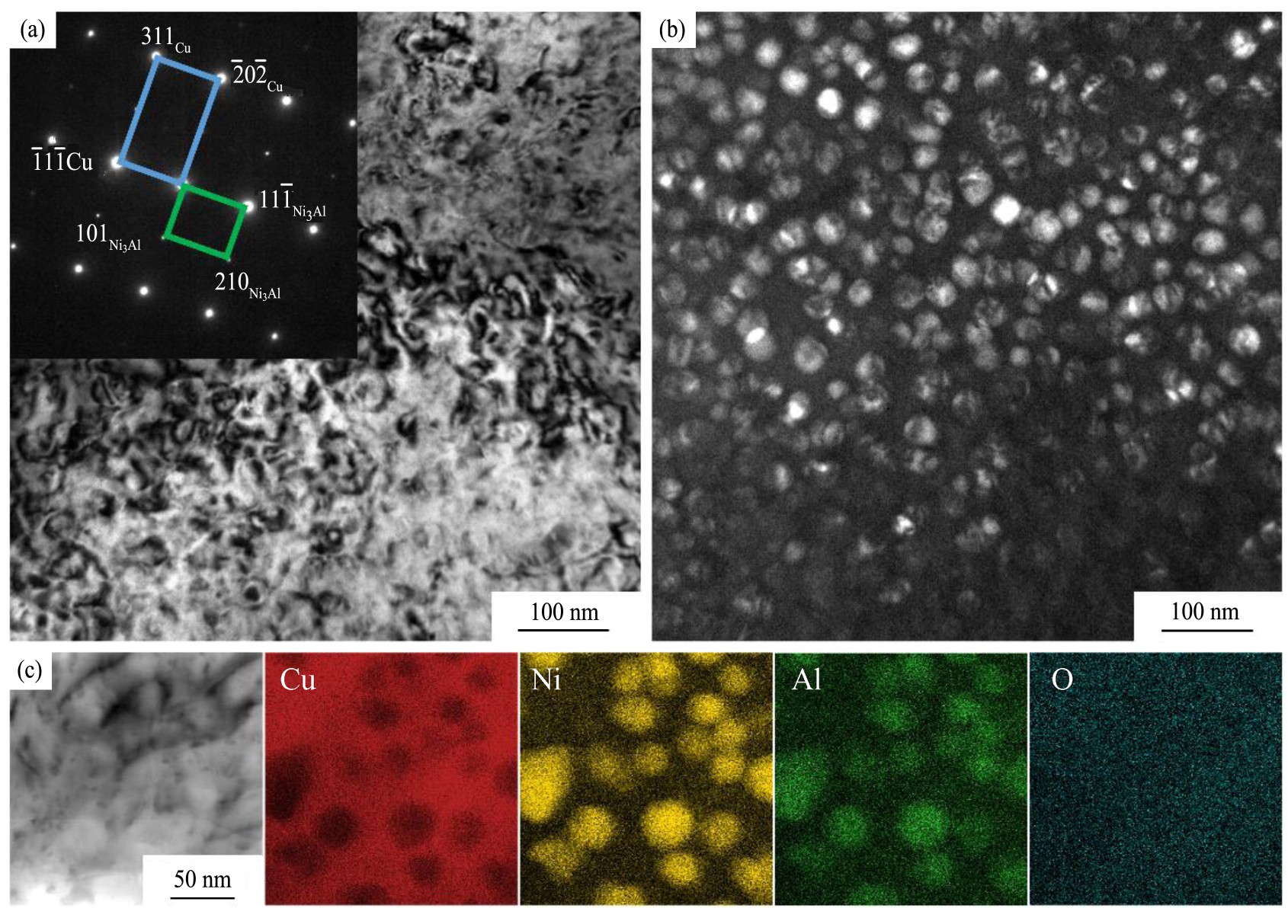网络首发时间: 2019-06-06 11:30
CuNi14Al3合金收缩环的工艺性缺陷研究
西安交通大学材料科学与工程学院金属材料强度国家重点实验室微纳尺度材料行为研究中心
陕西斯瑞新材料股份有限公司
摘 要:
CuNi14Al3合金收缩环通过真空熔铸,锻造,去应力退火等工艺制备而成。在生产工艺过程中常遇到以下问题:铸锭表面质量差,开坯前去除废料较多;锻造开裂;成品件无损探伤到孔洞、裂纹等缺陷。本研究采用金相显微镜(OM)、扫描电镜(SEM)、透射电镜(TEM)、能谱仪(EDS)以及维氏硬度仪等对CuNi14Al3合金收缩环每一步加工工艺后的显微组织和性能进行对比分析,观察到整个制备过程中主要存在四类工艺性缺陷,分别是显微孔洞、成分偏析、混晶组织以及裂纹。研究结果显示,这一系列工艺性缺陷的产生归因于合金的凝固特性,包括凝固时间、凝固顺序以及凝固收缩等,使得原始铸态合金枝晶组织粗大,一次枝晶干最长可达10 mm以上,且枝晶偏析、显微疏松严重,通过后续热加工,这些缺陷未能得到完全消除,甚至进一步形成混晶组织、裂纹等。研究表明,要抑制甚至消除以上缺陷的产生,需要从缺陷根源凝固入手,优化加工工艺,严格控制铸件品质。
关键词:
CuNi14Al3合金收缩环;孔洞;枝晶偏析;混晶组织;裂纹;
中图分类号: TG146.11
作者简介:冯瑞(1993-),女,陕西汉中人,硕士研究生,研究方向:金属材料,E-mail:fengruir@qq.com;;*陈凯,教授,电话:18291911676,E-mail:kchenlbl@gmail.com;
收稿日期:2019-04-09
基金:国家自然科学基金项目(51671154,91860109)资助;
Mechanism Study of Defect for Mation in CuNi14Al3 Shroud Rings
Feng Rui Chen Kai Qin Yuanbin Guo Chuangli Sun Junpeng Wang Qun
Center for Advancing Materials Performance from the Nanoscale(CAMP-Nano),State Key Laboratory for Mechanical Behavior of Materials,School of Materials Science and Engineering,Xi'an Jiaotong University
Shaanxi Sirui Advanced Materials Co.,Ltd
Abstract:
Strengthened by the L12 precipitates as such Ni3 Al,the CuNi14Al3 alloyis utilized to manufacture the shroud rings which areone of the key components of power generators.However,after the sequent processing procedures including vacuum melting casting,forging and stress relief annealing heat treatment,the poor surface quality,scrap removal induced materials waste,forging cracks and cavities were detected from time to time in the final products.To uncover the mechanism of the formation of these macroscopic defects,the microstructural features and mechanical properties of the CuNi14Al3 alloy after each crucial processing stage were studied by optical microscope(OM),scanning electron microscope(SEM),transmission electron microscope(TEM),energy dispersive X-ray spectroscope(EDS),and micro-hardness tester.Owing to the solidification characteristics of the CuNi14A13 alloy,including the solidification sequence,rate and shrinkage,the microstructure of the ingots featured of coarse dendritic structures,which was over 10 mm in length,with severe elemental segregation and micro-pores.Since nickel had higher melting point than copper,the precipitationinduced elements like nickel and aluminum to segregate in the dendritic cores with a segregation ratio up to 0.3 and 0.4,respectively.From the dendritic cores to the interdendritic regions,the shape of the precipitate particles changed gradually from large regularshaped cuboids(with the edge length around 200 nm) to fine irregular spherical shapes,with an average diameter of around 20 nm.The hardness values,obtained using the Vickers indenter,at the dendrite cores were higher than those in the interdendritic regions by approximately 13.1%.To investigate the tensile facture behavior of the ingot,the 45 ocone-shaped fractures revealed the brittleness characteristics of the alloy.However,at micro scale,the facture surface was dimple-shaped morphology with mass of pores,and the precipitate particles could be commonly observed at the bottom of the dimples,indicating that the stress concentration around the casting pores and shrinkage led to the fracture.After the sequent forging,the coarse dendrites and the micro-pores were inherited.Moreover,at the first step of the forging,the plastic deformation could not activate sufficient dynamic recrystallization,leading to the bimodal grain size distribution,in which the continuous small crystal grains distributed among the giant grains inherited from the casting organization.The bimodal microstructure led to the heterogeneity of the deformation partitions at further forging steps,which,in turn,induced the cracks to occur at the interfacial areas between the giant grains and the micro-pores.There was still no necking observed at the tensile facture of the forged specimens.Compared with those of the casting ingots,the dimples became shallower,which was an evidence of even more brittleness.A number of pores initiating from the casting cavities and shrinkage could still be found,and the pores were stretched by the large plastic deformation.All the defects,including dendritic structure,bimodal distributed grain size,pores and cracks,were left to the last processing step,stress relief annealing heat treatment.Unfortunately none of them could be eliminated by the annealing.The low temperature stress relief annealing treatment could not activate the recrystallization sufficiently and many giant grains were left over.Due to the high forging temperature,which was higher than the solutionizingheat treatment temperature of the CuNi14Al3 alloy,the cracks were oxidized as Al2O3,and the oxide particles along the cracks impeded the closure during forging.The densities of the alloys were measured to be 8.188 g·cm-3 after casting,8.245 g·cm-3 after forging,and 8.284 g·cm-3 after stress relief annealing,respectively.All values were significantly lower than the theoretical value(8.500 g·cm-3),revealing that the shrinkage cavities always existed and the defects could not be eliminated completely by the subsequent hot processing.Although the cracks emerging during the forging led to the failure of the product,the hardness and yield strength of the crack-free parts still met the requirements,mainly resulting from the dispersed precipitation hardening.From the dendritic cores to the interdendritic regions of the casting ingots,the size of the Ni3Al precipitate particles varied from 200 to 20 nm.The crystal structure of the precipitation was similar to the copper matrix and had the same orientation.After the forging and the annealing,the size of the precipitation became uniform at around 20-50 nm,which guaranteed the higher tensile strength at 855 MPa.The evolution of the precipitate particles proved that the forging and annealing processing was effective to achieve the required microstructure and mechanical properties,although it could not eliminate the casting defects.It could be concluded that,the formation of all the defects was attributed to the solidification characteristics of the alloy,including solidification rate,sequence and thermal shrinkage.Thus,the approach to improve the processing could be raised.Firstly,to improve the alloy composition by adding the grain refiner to promote the heteromorphy nucleation and/or the modifier to hinder the grain growth and the precipitating.Secondly,to optimize the casting processing by the sloping plate casting and the pressure casting to refine the grain size and restrain the shrinkage.The last but not the least,to add another homogenization annealing to eliminate the dendritic segregation and achieve better homogenization.
Keyword:
CuNi14Al3 shroud rings; cavity; dendritic segregation; mixed crystal structure; crack;
Received: 2019-04-09
Cu-Ni-Al合金在生产过程中易析出有序的Ll2型沉淀相Ni3Al等,存在复杂的析出形核和生长机制,是一种性能良好的沉淀强化型合金
然而在实际生产Cu Ni14Al3合金收缩环的过程中,常遇到:铸锭表面结疤严重,锻造开坯前去除废料较多;开坯、扩孔等锻造过程中,合金开裂;成品件无损探伤,检测到显微孔洞、裂纹等缺陷,这些问题严重降低了材料的利用率。合金缺陷问题一直以来都是制造业的一大难题,合金表面夹渣可能是因为合金中存在易氧化生渣元素
1 实验
Cu Ni14Al3合金收缩环经真空熔铸、锻造、去应力退火等多道工序,从Φ220 mm×1100 mm的圆柱铸锭加工为多个Φ391 mm/Φ361 mm×42 mm的成品环件,合金的化学成分如表1所示。
表1 Cu Ni14Al3合金的化学成分 下载原图
Table 1 Chemical composition of Cu Ni14Al3 alloy (%,mass fraction)

分别对不同工艺下的样品进行取样,经研磨、抛光后,采用2 g Fe(NO3)3+50 ml C2H5OH腐蚀剂腐蚀1 min,锻态和退火态样品为了观察到清晰的晶界,再采用50 ml HNO3+50 ml H2O腐蚀剂腐蚀10 s制备金相样品;采用CMT 5105万能电子拉伸试验机制备断口样品;采用BUEHLER Vibro Met 2振动抛光机,设置振幅60%,抛光时间4 h,制备电子背散射衍射(EBSD)样品;采用Helios Nanolab 600i聚焦离子束(FIB)在裂纹处进行提样,制备缺陷处的透射电镜(TEM)样品;采用FISCHIONE Model 200凹坑仪将Φ3 mm圆片样凹至坑底剩15~20μm,再采用FISCHIONE Model 1050离子减薄仪进行氩离子减薄,离子枪与样品上、下方均设为8°,电压为5 k V,减至样品底部出现小孔后,角度调整为4°,电压降至3 k V,最后减薄15 min,制备普通的Φ3mm透射电镜样品。
采用Axio Scope A1正立数字显微镜和Stemi2000立体显微镜(OM)进行金相分析;采用Hitachi SU6600场发射扫描电镜(SEM)和其EDAX Octane Elect Plus能谱仪(EDS)对缺陷形貌、微观组织及成分等进行分析;采用Helios Nanolab 600i聚焦离子束里的电子背散射衍射(EBSD)对晶粒大小等进行分析;采用JEOL 2100F透射电镜(TEM)和其JEOL EX-24065JGP能谱仪(EDS)对第二相、成分等进行分析;采用HXD-1000TMC/LCD维氏硬度仪进行硬度测试;采用CMT 5105万能电子拉伸试验机对拉伸性能进行测试;采用排水法对密度进行测试。
2 结果与讨论
2.1 铸态Cu Ni14Al3合金
Cu Ni14Al3合金铸锭表面质量较差,结疤严重,经下料将Φ220 mm的圆柱铸锭车加工为Φ200 mm后,合金表面光亮,无肉眼可见缺陷,对截面取样进行观察,如图1所示,图1(a)为取样示意图,箭头为凝固方向;图1(b,c)为同一截面处的金相组织,图1(b)位于近芯部,图1(c)位于外圆侧,近芯部相比于外圆侧过冷度小,冷却速度慢,枝晶组织更加粗大,一次枝晶干最长可达10 mm以上;图1(d,e)为同一竖直位置顶端和底端的二次电子图像,最后凝固的顶端相比于底端过冷度小,树枝晶更加粗大,并且在枝晶间存在大量显微疏松;图1(f,g)中F至G处能谱线扫描结果显示,枝晶干Ni,Al分布较多,而枝晶间较少,Ni,Al的偏析比分别为0.3,0.4,偏析较严重,枝晶干、枝晶间的平均硬度分别为HV242.5,HV 210.8,相差13.1%,性能不均匀。
二元Cu-Ni合金相图
经高分辨扫描电镜分析,观察到合金中存在大量第二相,如图2所示,其中2(a~c)为第二相从枝晶干中心变化到枝晶干边缘的二次电子图像,尺寸从200 nm变化到20 nm左右,形貌从立方形变化到部分接近球形;枝晶间处第二相含量以及尺寸都有所减小,如图2(d)所示。再经透射电镜分析,出现两套衍射斑如图2(e)所示,第二套斑较弱,其晶面间距恰与Ni3Al的晶面间距相符,明场像如图2(f)所示,由(100)晶面得到的暗场像可以清楚地分辨出Ni3Al析出相,如图2(g)所示。该析出相不仅具有L12型有序结构而且与所处的Cu基体的晶体结构相似,存在立方-立方取向关系:{100}Cu//{100}Ni3Al,<010>Cu//<010>Ni3Al,使合金的力学性能得到了很大的提高。
结合前面的能谱线扫分析,以及Cu-Ni-Al三元合金在800℃和700℃下的等温截面相图
图1 铸态Cu Ni14Al3合金的显微组织及成分分布
Fig.1 Microstructure and composition distribution of as-cast Cu Ni14Al3 alloy
(a)Sampling diagram;(b)Near core(Point B);(c)Round side(Point C);(d)Top(Point D);(e)Bottom(Point E);(f,g)EDS result
对铸态Cu Ni14Al3合金进行了拉伸性能测试,其拉伸断口形貌如图3所示,断口处有明显的颈缩现象,断口面形貌凹凸不平,接近45°杯锥状断裂,颜色呈浅棕黄色,微观形貌整体呈韧窝状,部分韧窝较深并且底部有第二相颗粒,表现出较好的塑性,其断裂方式为典型的韧性断裂。断口面还观察到大量的显微孔洞,与前面分析相结合,可以推测出这些显微孔洞大多数应为显微疏松,在外力的作用下变形、应力集中,造成最终的断裂。
2.2 锻态Cu Ni14Al3合金
2.2.1 开坯态Cu Ni14Al3合金
图2 铸态Cu Ni14Al3合金的析出相
Fig.2 Precipitated phases of as-cast Cu Ni14Al3 alloy
(a~d)Secondary electron images;(e)Diffraction pattern;(f)Bright field image;(g)Dark field image
经锻造第一道工序后的开坯件合金金相组织如图4(a,b)所示,依然存在粗大的树枝晶以及大量变形的显微孔洞,表明铸态缺陷遗传到了开坯态,未明显改善。仅通过金相观察不能清楚地看到晶界,但在电子背散射衍射模式下,可以观察到晶界处分布着大量细小晶粒,而其余部分仍然保留着原始大晶粒。Cu、Ni的层错能较低,Cu Ni14Al3合金锻造过程中发生动态再结晶。再结晶主要在晶界处形核,但原始晶粒粗大,开坯变形量又有限,因此动态再结晶不完全,形成如图4(c)所示的混晶组织。
2.2.2 扩孔态Cu Ni14Al3合金
图5所示为扩孔时直接开裂件的显微组织。其中图5(a)为远离裂纹处的金相组织,相比于开坯态,扩孔态可观察到大量再结晶区域,且再结晶晶粒细小,只存在个别巨晶。由于原始晶粒组织粗大,再加上加热温度、锻造变形量不均或锻造比不足等,造成再结晶不完全,出现混晶组织。在裂纹附近再结晶晶粒较少,裂纹走向沿着细小晶粒与粗大晶粒交界处如图5(b)所示。图5(c)为裂纹尖端处的二次电子图像,可观察到晶界处仍存在显微孔洞,说明显微疏松经第二道锻造工序后仍未完全消除。由于晶界处存在成分偏析和显微孔洞,再加动态再结晶形成的细小晶粒与原始粗大晶粒的变形能力不一致,在外力的驱使下,这些因素共同作用导致了最终的开裂。
2.2.3 碾环态Cu Ni14Al3合金
图6所示为碾环态Cu Ni14Al3合金的拉伸断口形貌。相比于铸态断口形貌特征,碾环态的断口无明显的颈缩现象,断口面形貌平直且颜色白亮接近合金本身颜色,微观形貌整体仍呈韧窝状,不同的是部分韧窝较浅、且较大,塑性有所下降。断面处依然可观察到大量显微孔洞,其数量相对减少、尺寸相对变小,说明孔洞类缺陷在经过最后一道锻造加工工序后,也未能完全消除,虽得到了很大的改善,但在外力的作用下其危害还是能表现出来。
图3 铸态Cu Ni14Al3合金拉伸断口形貌
Fig.3 Tensile fracture morphology of as-cast Cu Ni14Al3 alloy
(a)Low magnification;(b)Dimples;(c)Cavity
图4 开坯态Cu Ni14Al3合金的显微组织
Fig.4 Microstructure of Cu Ni14Al3 alloy in ingot formation state
(a)OM image;(b)SEM image;(c)EBSD image
图5 扩孔态Cu Ni14Al3合金的显微组织
Fig.5 Microstructure of Cu Ni14Al3 alloy in broaching state
(a)Far from cracks;(b,c)Near cracks
图6 碾环态Cu Ni14Al3合金拉伸断口形貌
Fig.6 Tensile fracture morphology of Cu Ni14Al3 alloy in rolling ring state
(a)Low magnification;(b)Dimples;(c)Cavity
2.3 退火态Cu Ni14Al3合金
退火态即最终的成品件,采用2 g Fe(NO3)3+50 ml C2H5OH的腐蚀剂浅腐蚀,得到如图7(a)所示的扭曲的粗大树枝晶,铸态的枝晶偏析缺陷在经过一系列的加工工艺后得到了改善但未完全消除,表明该缺陷具有遗传性。采用50 ml HNO3+50ml H2O的腐蚀剂腐蚀,得到如图7(b)所示的细小晶粒,相比于前两道锻造后的金相,混晶现象得到了很大的改善,但还是有极个别大晶粒存在;相比于扩孔态,再结晶晶粒有所长大,是因为在持续的高温锻造过程中,上一道工艺后再结晶不完全,再次锻造时,再结晶继续形核,已完成再结晶形核的晶粒开始长大,同时发生,最终仍得到的是混晶组织。
成品件经超声波探伤和渗透探伤,检测到显微孔洞和裂纹等缺陷,显微组织如图8所示。图8(a,b)为孔洞类缺陷,图8(c,d)为裂纹类缺陷,缺陷附近混晶现象较没有缺陷处严重,其中大晶粒有再结晶不完全遗留下的被拉长的晶粒,也有再结晶发生长大的晶粒。图8(e)为裂纹内部的高倍扫描图像,可观察到大量条状的第二相,采用聚焦离子束(FIB)对裂纹与基体交界处进行提样后,经透射电镜表征,结果如图8(f,g)所示,其中从图8(f)可以看出在裂纹与基体交界处存在大量条状第二相,而基体中无此第二相,根据图8(g)中该处合金主要元素的能谱(EDS)分析结果,可以基本确定该条状第二相为Al2O3。
图7 退火态Cu Ni14Al3合金显微组织
Fig.7 Microstructure of as-annealed Cu Ni14Al3 Alloy
(a)Etched mildly;(b)Etched deeply
原始晶粒粗大处显微疏松往往也较严重,多道锻造时,在外力和高温的共同作用下,部分显微疏松得到焊合,而遗留下的常被聚集或撕裂。尺寸较小的显微疏松易被聚集并发生畸变,产生如图8(b)所示的孔洞;尺寸较大的疏松处应力集中严重,较易开裂,正如所观察到的裂纹缺陷处总会有类似于节点的孔洞存在,并且在开裂后,偏析的晶界因熔点低就有可能被氧化,产生局部过烧,融掉部分晶粒,裂纹被不断扩大并被氧化产物Al2O3填充如图8(d)所示。
经锻造、去应力退火后,在高温和压力等共同作用下,析出相Ni3Al的尺寸减小,在扫描电镜下不能清晰观察到,经透射电镜表征可观察到析出相形状部分接近于球形,如图9所示,图9(a)为衍射斑和明场像,析出相Ni3Al与合金仍存在着相似的晶体结构,新的取向关系为:{110}Cu//{110}Ni3Al,<1-21>Cu//<1-21>Ni3Al;图9(b)为由(101)晶面得到的暗场像;图9(c)为合金中主要元素的能谱分析结果,可以清晰地观察到分布相对均匀的析出相,尺寸在20~50 nm,对合金起到了更好的强化效果。
2.4 其他性能对比
表2为部分工艺状态下,合金硬度、拉伸性能以及密度(ρ)的对比,表中Rm为抗拉强度,Rp0.2为屈服强度,As为延伸率,相比于纯铜,合金硬度得到了大大提高,铸态合金硬度就接近产品要求,其中析出相Ni3Al起到了关键作用;铸锭经锻造加工,大晶粒被破碎成细小晶粒,成分偏析、显微疏松得到些许改善,以及第二相分布及形貌的变化,使得拉伸性能得到了很大的提高;该合金的理论密度大约为8.5 g·cm-3
2.5 工艺改进措施
Cu Ni14Al3合金收缩环的一系列工艺性缺陷的形成,起因在于铸态缺陷,根源在于合金的凝固特性,包括凝固时间长,不同组元凝固顺序不同,凝固收缩等,使得枝晶粗大且偏析、显微疏松严重。因此,结合大规模工业生产特点,从该合金的凝固入手,改善铸造缺陷,提出以下改进措施:
图8 退火态Cu Ni14Al3合金缺陷处显微组织及EDS分析
Fig.8 Microstructure of defects in annealed Cu Ni14Al3 alloy
(a,b)Micro-cavities;(c,d)Cracks;(e~g)Internal cracks and EDS results
(1)改进合金成分
(2)优化浇注工艺
(3)增加均匀化退火工艺
3 结论
通过对比分析Cu Ni14Al3合金收缩环每道工艺后的显微组织和性能,得出以下结论:
1.该合金收缩环常出现的工艺性缺陷可归纳为以下4类:(1)显微孔洞,主要为显微疏松;(2)成分偏析,主要为枝晶偏析;(3)混晶组织;(4)裂纹。前两类缺陷在真空熔铸工艺下形成,部分遗传到了后续加工中,未能得到完全消除;后两类缺陷,在锻造工艺下形成,较严重处甚至锻造时直接开裂。
图9 退火态Cu Ni14Al3合金析出相Ni3Al微观形貌
Fig.9 Microstructure of Ni3Al precipitated phase of annealed Cu Ni14Al3 alloy
(a)Diffraction pattern and bright field image;(b)Dark field image;(c)EDS results
表2 不同工艺状态的合金性能对比 下载原图
Table 2 Comparison of properties of alloys in different technological states

2.该合金收缩环的锻造工艺缺陷为遗留下的熔铸缺陷演变而来,而熔铸缺陷的形成归因于合金的凝固特性,包括凝固时间、凝固顺序、凝固收缩等,若要减少或消除以上工艺性缺陷,需从凝固入手,严格控制铸件品质。
参考文献











